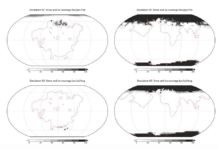
A new study has successfully reconstructed temperature from the deep sea to reveal how global ice volume has varied over the glacial-interglacial cycles of the past 1.5 million years.
Scientists have announced a major breakthrough in understanding Earth’s climate machine by reconstructing highly accurate records of changes in ice volume and deep-ocean temperatures over the last 1.5 million years.
The study, which is reported in the journal Science, offers new insights into a decades-long debate about how the shifts in Earth’s orbit relative to the sun have taken Earth into and out of an ice-age climate.
Being able to reconstruct ancient climate change is a critical part of understanding why the climate behaves the way it does. It also helps us to predict how the planet might respond to human-made changes, such as the injection of large quantities of carbon dioxide into the atmosphere, in the future.
Unfortunately, scientists trying to construct an accurate picture of how such changes caused past climatic shifts have been thwarted by the fact that the most readily available marine geological record of ice-ages — changes in the ratio of oxygen isotopes (Oxygen 18 to Oxygen 16) preserved in tiny calcareous deep sea fossils called foraminifera — is compromised.
This is because the isotope record shows the combined effects of both deep sea temperature changes, and changes in the amount of ice volume. Separating these has in the past proven difficult or impossible, so researchers have been unable to tell whether changes in Earth’s orbit were affecting the temperature of the ocean more than the amount of ice at the Poles, or vice-versa.
The new study, which was carried out by researchers in the University of Cambridge Department of Earth Sciences, appears to have resolved this problem by introducing a new set of temperature-sensitive data. This allowed them to identify changes in ocean temperatures alone, subtract that from the original isotopic data set, and then build what they describe as an unprecedented picture of climatic change over the last 1.5 million years — a record of changes in both oceanic temperature and global ice volume.
Included in this is a much fuller representation of what happened during the “Mid-Pleistocene Transition” (MPT) — a major change in Earth’s climate system which took place sometime between 1.25 million and 600 thousand years ago. Before the MPT, the alternation between glacial periods of extreme cold, and warmer interglacials, happened at intervals of approximately 41,000 years. After the MPT, the major cycles became much longer, regularly taking 100,000 years. The second pattern of climate cycles is the one we are in now. Interestingly, this change occurred with little or no orbital forcing.
“Previously, we didn’t really know what happened during this transition, or on either side of it,” Professor Harry Elderfield, who led the research team, said. “Before you separate the ice volume and temperature signals, you don’t know whether you’re seeing a climate record in which ice volume changed dramatically, the oceans warmed or cooled substantially, or both.”
“Now, for the first time, we have been able to separate these two components, which means that we stand a much better chance of understanding the mechanisms involved. One of the reasons why that is important, is because we are making changes to the factors that influence the climate now. The only way we can work out what the likely effects of that will be in detail is by finding analogues in the geological past, but that depends on having an accurate picture of the past behaviour of the climate system.”
Researchers have developed more than 30 different models for how these features of the climate might have changed in the past, in the course of a debate which has endured for more than 60 years since pioneering work by Nobel Laureate Harold Urey in 1946. The new study helps resolve these problems by introducing a new dataset to the picture — the ratio of magnesium (Mg) to calcium (Ca) in foraminifera. Because it is easier for magnesium to be incorporated at higher temperatures, larger quantities of magnesium in the tiny marine fossils imply that the deep sea temperature was higher at that point in geological time.
The Mg/Ca dataset was taken from the fossil record contained in cores drilled on the Chatham Rise, an area of ocean east of New Zealand. It allowed the Cambridge team to map ocean temperature change over time. Once this had been done, they were able to subtract that information from the oxygen isotopic record. “The calculation tells us the difference between what water temperature was doing and what the ice sheets were doing across a 1.5 million year period,” Professor Elderfield explained.
The resulting picture shows that ice volume has changed much more dramatically than ocean temperatures in response to changes in orbital geometry. Glacial periods during the 100,000-year cycles have been characterised by a very slow build-up of ice which took thousands of years, the result of ice volume responding to orbital change far more slowly than the ocean temperatures reacted. Ocean temperature change, however, reached a lower limit, probably because the freezing point of sea water put a restriction on how cold the deep ocean could get.
In addition, the record shows that the transition from 41,000-year cycles to 100,000-year cycles, the characteristic changeover of the MPT, was not as gradual as previously thought. In fact, the build-up of larger ice sheets, associated with longer glacials, appears to have begun quite suddenly, around 900,000 years ago. The pattern of Earth’s response to orbital forcing changed dramatically during this “900,000 year event,” as the paper puts it.
The research team now plan to apply their method to the study of deep-sea temperatures elsewhere to investigate how orbital changes affected the climate in different parts of the world.
“Any uncertainty about Earth’s climate system fuels the sense that we don’t really know how the climate is behaving, either in response to natural effects or those which are man-made,” Professor Elderfield added. “If we can understand how earlier changes were initiated and what the impacts were, we stand a much better chance of being able to predict and prepare for changes in the future.”
Note : The above story is reprinted from materials provided by University of Cambridge, via EurekAlert!, a service of AAAS. The original story is licensed under a Creative Commons license.










